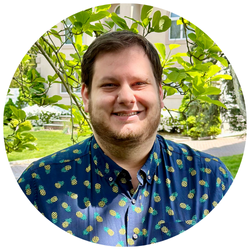La mitología romántica del ermitaño está profundamente arraigada en cada persona creativa. Como escritor, la idea resulta particularmente atractiva: desaparecer de la vista para resurgir meses después con la siguiente novela única en su generación.
Pero, contrariamente a la creencia popular, la leyenda del brillante ermitaño es probablemente sólo eso: una leyenda, un ideal, un arquetipo, un sueño.
Muchos escritores prolíficos pensaron encarnar la Los reclusos románticos, como William Wordsworth, Henry David Thoreau y Emily Dickinson, en realidad desafían el estereotipo.
Un estudio más detallado revela que nosotros, como escritores, debemos vivir plenamente presentes en el mundo.

Estos no son los ermitaños que estás buscando
Tomemos como ejemplo al popular poeta William Wordsworth. Su poesía está llena de hermosas odas al mundo natural y a los pensamientos que nos llegan en la soledad. De su poema"Vagaba solo como una nube" :
Que flota en lo alto sobre valles y colinas,
Cuando de repente vi una multitud,
Una hueste de narcisos dorados;
Junto al lago, bajo los árboles,
Revoloteando y bailando en la brisa.
En estado de ánimo vacío o pensativo,
Ellos destellan sobre ese ojo interior
¿Cuál es la dicha de la soledad?
Y entonces mi corazón se llena de placer,
Y baila con los narcisos.
A pesar de la percepción que el público tenía de Wordsworth como un “ermitaño”, en realidad tenía una vida social activa y mantenía relaciones saludables con otros escritores.
Además, se mantuvo activo en cuestiones políticas y sociales de la época y viajó con frecuencia, aspectos de su vida que influyeron enormemente en su obra.
Otra poeta famosa, supuestamente conocida por su estilo de vida ermitaño, fue Emily Dickinson. Pero Dickinson también se mantuvo activa durante su juventud, manteniendo relaciones sociales y manteniendo constantemente vínculos a través de la correspondencia.
De hecho, no fue hasta los últimos años de vida de Dickinson que ella se volvió más solitaria debido a problemas de salud mental.
¡Incluso Henry David Thoreau solo vivió en su remota cabaña en Walden Pond durante dos años! En Walden , escribió :
“No soy un ermitaño por naturaleza, pero podría sentarme como el más asiduo de los asiduos al bar, si mi trabajo me llamara allí”.
Para escribir, primero hay que vivir
Sin embargo, no basta con no ser un escritor aislado del mundo. Los escritores clásicos a lo largo de la historia han dado testimonio de la necesidad de levantarse y vivir , de experimentar el mundo, antes de sentarse a escribir sobre él.
El novelista de la Generación Perdida,Ernest Hemingway, dijo una vez:
"Para escribir sobre la vida, primero hay que vivirla."
Incluso Thoreau , uno de los ejemplos más famosos del arquetipo de escritor-ermitaño, proclamó:
"¡Qué vano es sentarse a escribir cuando no te has levantado a vivir!"
Y Mark Twain nos dijo:
"Escribe lo que sabes."
Los viajes y experiencias de Twain impactaron profundamente a él y a su escritura; si hubiera sido un ermitaño, probablemente nunca hubiera adquirido el conocimiento necesario para dar forma a historias en torno a la compleja sociedad que lo rodeaba: la vida durante la Guerra Civil estadounidense y un período rápido de industrialización y urbanización en Estados Unidos.
Muchos de los grandes escritores de los últimos siglos, incluso aquellos considerados gloriosos ermitaños, rechazaron la idea de que la soledad conduciría repentinamente a una gran obra. Al menos no sin antes vivir.
El Romanticismo de la Soledad
Si los más grandes escritores ermitaños de la literatura clásica no fueron tal cosa, ¿por qué el romanticismo de la idea persiste hasta nuestros días?
La idea probablemente surgió durante la época romántica, entre finales del siglo XVIII y mediados del XIX, cuando ciertos escritores veneraban el individualismo. Si bien Wordsworth y Thoreau pertenecían a este grupo, su énfasis en la soledad es malinterpretado.
Contrariamente a la creencia popular, los grandes poetas no abogaban por que los escritores abandonaran a sus amigos y familiares, sus aficiones, sus trabajos, su vida entera, en busca de la soledad. En cambio, Wordsworth y Thoreau buscaban destacar el valor del tiempo personal y, de hecho, del mundo natural, como una forma de fomentar una comprensión más profunda del mundo en general e inspirarse.
Los medios de comunicación modernos aún no han contribuido a disipar el mito. Películas populares como Capote muestran el estilo de vida aislado del autor principal. De igual manera, la novela Big Sur retrata al novelista y poeta Jack Kerouac mudándose a una cabaña aislada para completar su proceso. Pero, en realidad, ninguno de los dos autores se aisló por completo de la sociedad.
La noción del genio solitario es una leyenda, y tratar de recrear ese tipo de estilo de vida en realidad puede obstaculizar la creatividad, sin mencionar la salud mental.
Construyendo la soledad moderna
Si bien nadie recomienda retirarse por completo de la sociedad para escribir un libro, es definitivamente cierto que los escritores modernos se enfrentan a una distracción de un nivel desconocido para Wordsworth y sus contemporáneos.
La tecnología moderna es más eficaz que nunca para captar y retener nuestra atención. Esto significa que, en dosis adecuadas, el aislamiento puede beneficiar al escritor moderno. Simplemente eliminar las distracciones puede ayudar a los escritores a concentrarse mejor en su trabajo y a tener más espacio para explorar ideas.
¿La buena noticia? No necesitas mudarte a una cabaña en el bosque. Solo necesitas un Freewrite .
Como escritores, es común sentirnos culpables cuando no estamos escribiendo. Es un poco como tener siempre tarea. Pero es importante recordar que incluso los grandes se aseguraron de vivir.
Así que no canceles a tus amigos. No pases cada momento despierto con los ojos pegados a la página en blanco. No vendas todo y te mudes a París para canalizar las almas de la Generación Perdida.
Vive tu vida
Vive tu vida y escribe sobre ella.




























